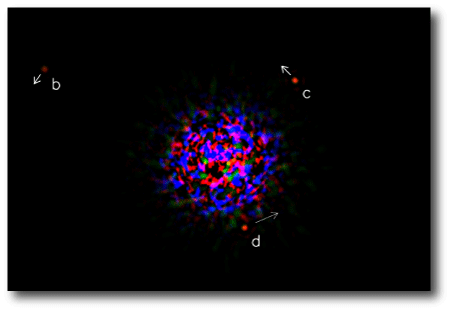Last night, I noticed Venus and Jupiter hanging low and bright about ten degrees apart in the deep blue twilight. Noctilucent cirrus clouds hinted that the full Moon had just risen on the other side of the sky. No matter how intricate the detail in a radial velocity curve, no matter how fine-grained the transit ingress, there’s something undeniably tantalizing and mysterious about the direct image. There’s a certain solidity to seeing with your own eyes.

The embargo just lifted, and by now, the news of the images of the planets orbiting HR 8799 and Fomalhaut are all over the media. NYTimes, check. Washington Post, check. Fox News, check.
I was very happy to see that the media coverage of these two amazing, largely independent discoveries ended up quite fair and balanced. I had been wondering whether perhaps HR8799 would get shouldered out of the limelight. There’s definitely something to be said for steppin’ into the ring with the HST Press Machine at your back, and a cool-looking picture of a planet orbiting (of all stars!) Fomalhaut. A star with a name like a rocket.
Fomalhaut, furthermore is Magnitude 1. HR8799 checks in with B=6.198 and V=5.964. “It’s up now, in the Great Square of Pegasus, slightly too dim to see with the naked eye. But your cat’s eyes are actually sensitive enough to see it! If you’re so inclined, you can make your cat go outside tonight and share in this historic discovery.”
I think it’s quite significant that these planets have been detected around stars that are more massive than the Sun. We already know from the radial velocity surveys (and specifically the targeted surveys of John Johnson and Bunei Sato) that higher-mass Jovian planet formation was more efficient around higher-mass stars than around stars of solar mass and below. Johnson and Sato surveyed “retired” A-type stars that are now turning into red giants, and which are cool enough to have the deep lines in their spectra that the RV-detection method requires. Johnson and Sato both independently found that these stars are frequently producing planets that are more massive than Jupiter in orbital periods of several hundred days.
Sato’s detection in early 2007 of a 7.6 Jupiter-mass planet orbiting Epsilon Tauri (2.7 solar masses) in the Hyades is probably a good example of the type of planet that’s showing up in these new images, and Eps Tau b provides good support for the case that this category of objects arose from gravitational instability. The Hyades were a tough environment for planet formation via core accretion, due to the intense UV radiation that caused the disks to lose gas quickly (see this oklo post).
Remnant debris disks would be expected around young stars that had massive enough disks to trigger gravitational instability. Also, in general, the more massive the star, the more massive the disk. And finally, if the planets formed via gravitational instability, one wouldn’t expect a bias toward high metallicity. If this idea is correct, as more of these planets are imaged, there shouldn’t be a metallicity correlation with the parent star.
Bruce Macintosh was kind enough to point me to some links that his team has set up. The images and movies are well worth a visit:
Travis and Christian put together a temporary holding pen at
http://www.photospheres.us/barman/HR8799/My personal favorites are the “real” orbital motion one
http://www.photospheres.us/barman/HR8799/Movie00-HR8799-real-orbitalmotion.movand the movie showing the rotational imaging technique:
http://www.photospheres.us/barman/HR8799/Movie04-HR8799-adi.mov
(left panel is raw Keck images with the image derotator off, so artifacts
are fixed while stuff on the sky rotates; middle panel is image with a
weighted-moving-average PSF subtracted; rightmost is the cumulative derotated
image.)Also a finding chart showing HR8799 and 51 Peg.
The HR8799 family portrait, with three planets zipping around on Keplerian orbits immediately brings to mind our own outer solar system. Ironically, however, if the GI formation hypothesis is correct, we’re actually observing planetary systems that have even less kinship to our own than do systems like HD 209458b and 51 Peg that harbor hot Jupiters (which oddball as they seem, probably formed via core accretion, just like Jupiter).

Are there any practical differences between gas giants formed by core accretion vs gas collapse? At these sizes, both types will have ~nebular bulk compositions. Does it make any difference with regards to moons or rotation speeds or anything else like that?
When a gas giant gets up to several Jovian masses, its bulk composition is pretty similar, regardless of whether it formed by GI or core accretion. Early on, core accretion planets will be fainter (unless you are lucky enough to catch one during the rapid gas accretion phase). By the age of HR8799 and Fomalhaut, though, the luminosity differences will be pretty negligible. Seems like both core accretion planets and GI-induced planets should have satellite-forming circumplanetary disks as well…
Given the very long periods and young stars in these studies, can core accretion act fast enough to create a Jupiter-sized planet that far out? I thought one of the arguments for outward migration of Neptune and Uranus in our system is that in their current orbits, accretion would take longer than the age of the solar system.
Pingback: Centauri Dreams » Blog Archive » Reflections on Visible Exoplanets
Interesting that HR 8799 is a Lambda Bootis star. Are any other planetary systems known around chemically-peculiar stars?
(Oh yes, and it’s a Gamma Doradus variable as well)